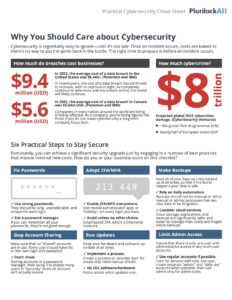The Trojan Horse in Cybersecurity: A Deep Dive
In the realm of cybersecurity, the term “Trojan Horse” is a concept deeply rooted in ancient Greek mythology. The story of the Trojan War, where the Greeks employed a colossal wooden horse to infiltrate the city of Troy, serves as a poignant metaphor for a class of cyber threats that have plagued the digital landscape for decades. A Trojan Horse, in the context of cybersecurity, represents a deceptive and malicious software or code hidden within a seemingly harmless facade. This deceptive nature has made Trojans one of the most formidable and persistent threats in the cyber world. This deep dive aims to provide a comprehensive understanding of what Trojan Horses are, why they matter in the realm of cybersecurity, and an in-depth analysis of their importance.
What is a Trojan Horse?
At its core, a Trojan Horse is a type of malware or malicious software that disguises itself as legitimate or benign software, only to carry out nefarious actions once it gains access to a target system. The name is derived from the legendary Greek tale, where Greek soldiers infiltrated the city of Troy by hiding inside a massive wooden horse, which was perceived as a gift. In the cyber realm, the Trojan Horse operates on a similar principle, deceiving users or security systems into allowing it access to a system, where it can wreak havoc.
Trojan Horses come in various forms and can be classified based on their primary malicious intent:
- Backdoor Trojans: These Trojans are designed to create a secret backdoor or entry point into a compromised system, allowing cybercriminals to gain unauthorized access. Once inside, they can control the system, steal data, or use it as a launching point for further attacks.
- Downloader Trojans: These Trojans are responsible for downloading and installing additional malware onto the compromised system. They may initially appear as harmless files or applications but serve as a gateway for more destructive payloads.
- Data-Stealing Trojans: As the name suggests, these Trojans are focused on stealing sensitive data such as login credentials, financial information, or personal files. They often operate silently, exfiltrating data to remote servers without the user’s knowledge.
- Ransomware Trojans: Ransomware Trojans encrypt the victim’s files, rendering them inaccessible until a ransom is paid. The ransom demand is usually accompanied by a threat to permanently delete the data if the ransom isn’t paid within a specified time frame.
- Spyware Trojans: These Trojans are designed to spy on the user’s activities, capturing keystrokes, monitoring web browsing, and capturing screenshots. They are often used for espionage or surveillance purposes.
- Banking Trojans: This category targets online banking and financial transactions. Banking Trojans often inject malicious code into web browsers, intercepting sensitive financial information, and redirecting transactions to attacker-controlled accounts.
- Remote Access Trojans (RATs): RATs provide cybercriminals with full control over a compromised system, allowing them to execute commands, capture screenshots, access files, and even control the webcam and microphone.
Why Trojan Horses Matter
Understanding the significance of Trojan Horses in the cybersecurity landscape requires a deeper exploration of their capabilities, impact, and the reasons behind their persistence.
1. Deception and Trust Exploitation
Trojan Horses rely on deception and the exploitation of trust, making them exceptionally potent threats. By impersonating legitimate software or files, they bypass initial suspicion, often evading antivirus and intrusion detection systems. This trust exploitation makes them effective vehicles for various cybercrimes, from data theft to espionage.
2. Versatility and Adaptability
Trojan Horses are incredibly versatile, capable of carrying out a wide range of malicious activities. Their versatility stems from their ability to be customized or repurposed by cybercriminals, making them suitable for various attack scenarios. Attackers can modify Trojans to fit specific targets, making them particularly challenging to detect.
3. Persistent Threat Landscape
Trojan Horses have maintained their relevance over the years because they adapt to evolving technologies and security measures. Cybercriminals continually refine their tactics, techniques, and procedures (TTPs) to ensure Trojans remain effective. As a result, they persist as a prominent threat in the ever-changing cybersecurity landscape.
4. Financial Gain and Espionage
Trojan Horses serve as valuable tools for cybercriminals pursuing financial gain or espionage. Banking Trojans target financial institutions, siphoning funds from victims’ accounts, while espionage-focused Trojans can infiltrate government agencies, corporations, and critical infrastructure, stealing sensitive information.
5. Exploitation of Vulnerabilities
Trojan Horses often exploit vulnerabilities in operating systems, applications, or human behavior. The success of a Trojan depends on users opening infected email attachments, visiting compromised websites, or running malicious files, which underscores the importance of user education and robust cybersecurity practices.
The Evolution of Trojan Horses
The evolution of Trojan Horses has closely mirrored the development of technology and the shifting threat landscape. Understanding their evolution provides insights into why they remain a significant concern in cybersecurity.
Early Instances: The Birth of Trojans
The concept of Trojan Horses in the digital realm dates back to the 1980s when early malware specimens emerged. The term “Trojan Horse” was first coined during this era, and the initial Trojans were relatively simple in design, often spreading via infected floppy disks. Their primary function was to trick users into executing them, initiating their malicious activities.
Internet Proliferation: Remote Access Trojans
As the internet became more accessible, Trojans evolved to exploit this newfound connectivity. Remote Access Trojans (RATs) gained prominence during this period, allowing attackers to establish remote control over compromised systems. This development expanded the scope of Trojans from mere nuisances to potent tools for cyber espionage and data theft.
Commercialization and Banking Trojans
In the 2000s, a significant shift occurred with the commercialization of Trojans. Cybercriminals recognized the profit potential in targeting online banking and financial transactions. Banking Trojans like Zeus and SpyEye emerged, specifically designed to intercept banking credentials and facilitate fraudulent transactions. This era marked the convergence of cybercrime and financial gain.
Advanced Persistence Threats (APTs)
In the 2010s, nation-state actors and advanced cybercriminal groups began leveraging Trojans as part of advanced persistent threats (APTs). These sophisticated Trojans, often custom-built for specific targets, aimed at infiltrating critical infrastructure, government agencies, and large corporations. Examples include Stuxnet, Duqu, and Flame, which demonstrated the potential for Trojans to disrupt critical systems and conduct state-sponsored espionage.
Modern Trojan Landscape
In recent years, Trojans have continued to evolve. They now incorporate evasion techniques, polymorphic code, and advanced obfuscation to avoid detection. They exploit zero-day vulnerabilities, utilize social engineering tactics, and frequently target mobile devices, which have become a new frontier for Trojan attacks. The emergence of cryptocurrency has also facilitated anonymous payments, enabling cybercriminals to receive ransom payments without detection.
The Trojan Horse Lifecycle
Understanding the lifecycle of a Trojan is crucial for effective defense and mitigation. The typical lifecycle consists of several stages:
1. Infection
Trojans enter a system through various vectors, such as malicious email attachments, infected downloads, compromised websites, or USB drives. Infection may also occur through exploiting software vulnerabilities or taking advantage of social engineering to trick users into running malicious code.
2. Execution
Once inside a system, the Trojan executes its payload. Depending on its type and purpose, this payload can include establishing a backdoor, stealing data, encrypting files, or carrying out other malicious actions.
3. Persistence
To maintain a presence on the compromised system, Trojans often employ persistence mechanisms. These mechanisms ensure that the Trojan can survive system reboots and security updates. Common persistence techniques include registry modifications, startup program alterations, or service creation.
4. Communication
Trojans typically establish communication channels with remote command and control (C&C) servers. This allows cybercriminals to send instructions to the Trojan, receive stolen data, or update the malware. These communications are often encrypted to avoid detection.
5. Data Exfiltration or Exploitation
Depending on their purpose, Trojans either exfiltrate sensitive data or carry out their malicious tasks. Data-stealing Trojans capture and send confidential information to remote servers, while ransomware Trojans encrypt files and demand ransoms.
6. Covering Tracks
To evade detection, Trojans often attempt to cover their tracks by deleting logs, modifying system files, or employing anti-forensic techniques. This makes it challenging for investigators to trace the source of the attack.
7. Removal or Detection
Finally, Trojans may be detected by security software or incident response teams. Removal involves identifying and eradicating all traces of the Trojan from the compromised system, which can be a complex and time-consuming process.
Trojan Horse Mitigation and Defense Strategies
Effectively mitigating the threat posed by Trojan Horses requires a multi-faceted approach that combines technology, user education, and proactive security measures. Here are key strategies to consider:
1. Antivirus and Endpoint Protection
Deploying robust antivirus and endpoint protection solutions can help detect and block known Trojans. These solutions rely on signature-based and heuristic analysis to identify malicious files and behavior.
2. Patch Management
Regularly updating operating systems, applications, and software is crucial to patch known vulnerabilities that Trojans often exploit. Vulnerability management programs can help organizations stay ahead of potential threats.
3. Email Security
Implementing email security solutions that filter out malicious attachments and URLs can prevent Trojans from entering the network through phishing attacks.
4. User Education and Awareness
Educating users about the dangers of downloading files from untrusted sources, clicking on suspicious links, and opening email attachments from unknown senders can reduce the likelihood of Trojan infections.
5. Network Segmentation
Segmenting networks into isolated zones can contain the spread of Trojans and limit their lateral movement within an organization’s infrastructure.
6. Intrusion Detection and Prevention Systems (IDPS)
IDPS can detect suspicious network and system activities associated with Trojans and trigger alerts or block malicious traffic.
7. Behavioral Analysis
Behavioral analysis tools can identify abnormal system behavior, helping to detect Trojans that may have evaded signature-based detection.
8. Zero Trust Security
Implementing a zero-trust security model assumes that no user or device can be trusted by default. Access control and authentication are strictly enforced, limiting the impact of Trojan infections.
9. Incident Response Planning
Developing and regularly testing an incident response plan ensures that organizations can respond effectively when a Trojan is detected, minimizing damage and recovery time.
The Ongoing Battle
The battle against Trojan Horses in cybersecurity is ongoing, and it is marked by continuous innovation on both sides—cyber defenders and cybercriminals. Trojans continue to evolve in response to security measures, exploiting new attack vectors, and employing advanced evasion techniques. Simultaneously, security professionals work tirelessly to develop better detection and mitigation strategies.
The importance of understanding and addressing the Trojan Horse threat cannot be overstated. Failure to do so can result in significant financial losses, data breaches, and damage to an organization’s reputation. In the face of this persistent threat, organizations must remain vigilant, continually adapt their defenses, and invest in cybersecurity education and training to protect against Trojan Horses and other evolving cyber threats.
Conclusion
Trojan Horses represent a timeless and formidable threat in the realm of cybersecurity. Their ability to deceive and exploit trust makes them a favored tool for cybercriminals pursuing a wide range of malicious objectives, from financial gain to espionage. The evolution of Trojans has closely mirrored technological advancements, enabling them to persist as a prominent threat in the ever-changing cybersecurity landscape.
Mitigating the Trojan Horse threat requires a comprehensive and multi-faceted approach that encompasses technology, user education, and proactive security measures. Organizations must remain vigilant, continually adapt their defenses, and invest in cybersecurity to protect against Trojan Horses and other evolving cyber threats.
As the digital world continues to evolve, Trojan Horses will undoubtedly evolve with it. The battle against these deceptive threats underscores the importance of cybersecurity as an ongoing and ever-adaptive discipline. Staying informed, prepared, and proactive is the key to defending against Trojan Horses and ensuring the security of digital systems and sensitive data in an increasingly interconnected world.











